It’s been a busy old year here at Riot Towers and we’ve sent Allan far and wide to watch bands – well, the Isle of Wight to Edinburgh. On his travels, he’s bumped in to some incredible musicians, but also his fair share of writers and photographers as well. As a result, we’ve invited a few guests from other websites and publications to join in the year-end fun and we’ve got some cracking live pictures coming up over the next few weeks. Allan insisted on pulling rank and starting with his own favourite shots of female artists. As always, in no particular order:
Elle Exxe at the Isle of Wight Festival – An invite to go to the Isle of Wight with a group of artists, writers and photographers courtesy of Ray Jones and Time Out; don’t mind if I do. No photo pass, but it really didn’t matter. It only stopped me from getting to the other side of the pit barrier. The event was broadcast by Sky Arts, which meant a full lighting production on various stages. The Big Top on Saturday afternoon was the main attraction; I’d photographed Elle Exxe the previous October at an awards ceremony and I was expecting striking imagery. Here’s my favourite shot from the set:
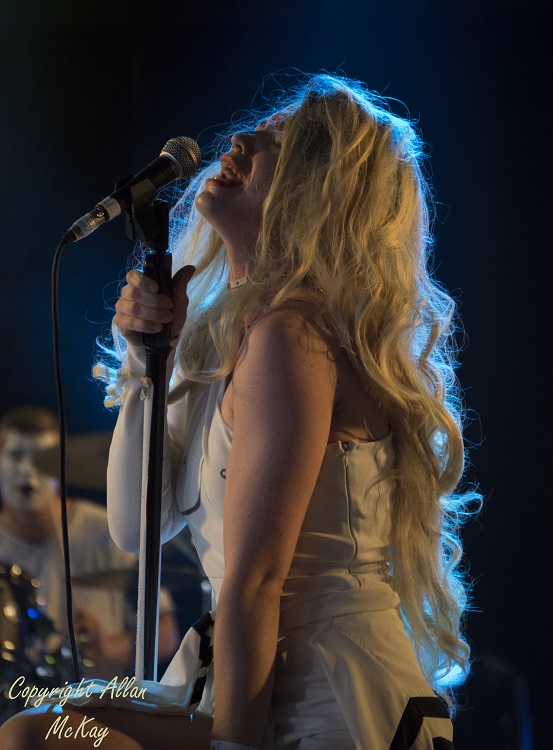
Rider @Water Rats – Rider has been around for a while, quietly plotting world domination while putting her band together; this was their debut gig. Rider is very striking visually and it should have been relatively easy to get some interesting images. Right at the front with a wide –angle lens looked favourite, but it was a looking a bit average until I changed up to the telephoto zoom and moved to the back of the room. Like the Elle Exxe shot it needed very little editing to create something a bit special.
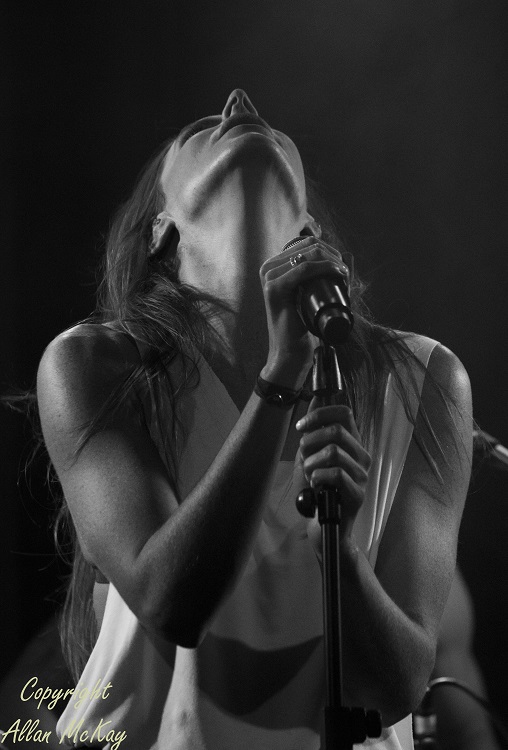
Kelly Halloran @The Union Chapel – Kelly Halloran is a stunningly good fiddle player who tours with Rachael Sage. I was more than happy to accept a press pass from Rachael’s PR team for her support gig with Howard Jones at The Union Chapel. It’s a lovely venue for photographers; you shoot from the side of the stage if you like and, at this gig, there was no pit and no three song rule. That was the lucky bit, because this shot was taken towards the end of the set. I loved the purple lighting on Kelly’s black suit and I had spotted the unusual angle from the side of the stage. The lights weren’t cycling wildly so it was just a question of getting into position when they blended into purple and:
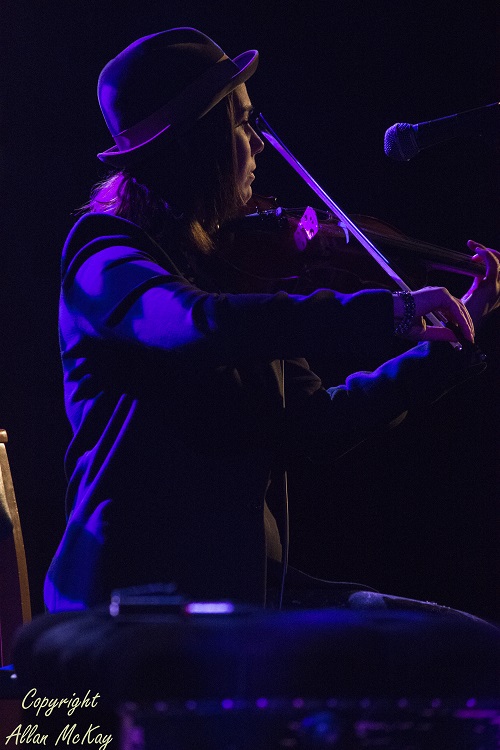
Hollie Rogers @Acoustic Sex – Remember I told you about the Isle of Wight? You are paying attention aren’t you? Well, one of the people I met there was Hollie Rogers. We were introduced, I was impressed and did a quick search online; it was enough to make me decide to go and see her play five days later. She obviously impressed Ray Jones as well because he booked her to play at his Acoustic Sex showcase at 2 Northdown a few weeks later. There are no fancy coloured lights, but the lighting levels are pretty good so there are no excuses. Hollie’s songs are generally pretty intense and her voice is incredibly powerful, but there’s another side. She has a wicked sense of humour and that’s the side I tried to catch in this shot:
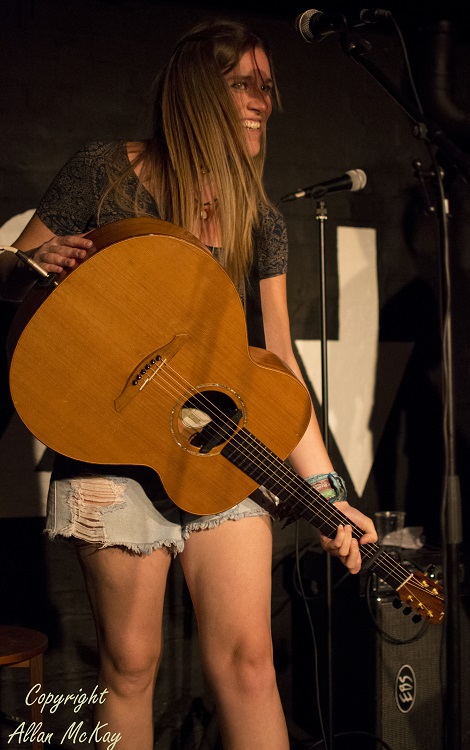
Mollie Marriott @The Borderline – I was lucky enough to see the first and second (and a few more) gigs that Mollie played with her full band. Like everyone else in this list, she’s a terrific singer and writer; she also has a band that are great musicians and lovely people. They don’t just play music together, they’re a team and it shows in the way they interact on stage and off. Mollie’s one of those people (a bit Like Hannah Aldridge) that I never get tired of photographing; there’s always something different to capture. This was a shot from the refurbished Borderline before they really got the lighting sorted out. A challenge, but you make the most of the hand you’re dealt:
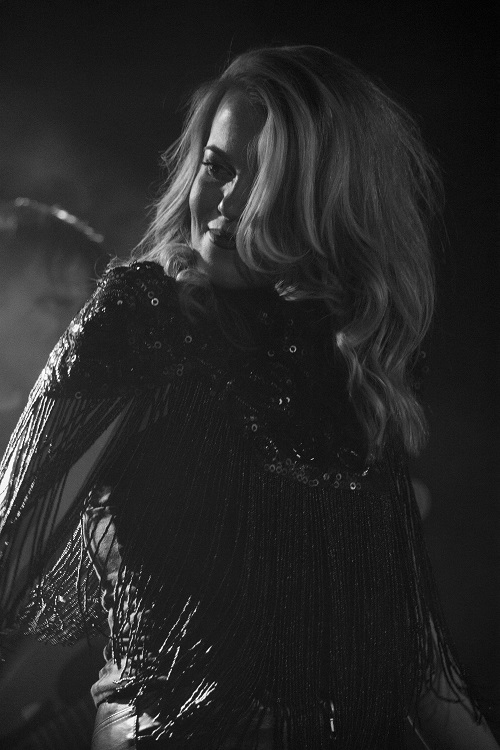
It’s been a huge pleasure to meet and photograph these people, but it’s not just about the visuals; they are all gifted performers that you should make the effort to see if you get the chance.
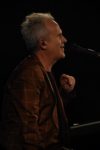 Well, that was an interesting experience. For most of the evening I felt like a gatecrasher at a meeting of a benevolent religious sect. I never felt unwelcome but, as an impartial observer (I liked the run of singles between 1983 and 1986) I couldn’t share the devotion of the fans who had all the albums, knew all the songs, B-sides included, and had stayed with Howard Jones for over thirty years. And I’ve never seen so many couples in their forties/fifties cuddling at a gig. These were people who had grown up with Howard’s music and made it part of their lives. Taking their cue from his Buddhist beliefs, they were ready to welcome outsiders to the celebration; they certainly extended their welcome to Rachael Sage as a support act.
Well, that was an interesting experience. For most of the evening I felt like a gatecrasher at a meeting of a benevolent religious sect. I never felt unwelcome but, as an impartial observer (I liked the run of singles between 1983 and 1986) I couldn’t share the devotion of the fans who had all the albums, knew all the songs, B-sides included, and had stayed with Howard Jones for over thirty years. And I’ve never seen so many couples in their forties/fifties cuddling at a gig. These were people who had grown up with Howard’s music and made it part of their lives. Taking their cue from his Buddhist beliefs, they were ready to welcome outsiders to the celebration; they certainly extended their welcome to Rachael Sage as a support act.
I’m slightly biased; I saw Rachael a couple of times last year and loved her “Choreographic” album. Accompanied by her usual duo partner, violinist Kelly Halloran, she played a short (thirty minute) set taken mainly from the latest album, featuring “Loreena”, “I Don’t Believe It” and “Heaven is a Grocery Store Clerk” and a new, unreleased, song about the Dakota Access Pipeline and the plight of the people of Standing Rock Reservation. The Howard Jones fans warmed to Rachael’s very personal style of writing and the powerful performance of her guitar and keyboard-driven songs punctuated by Kelly’s violin (ever heard wah-wah violin before?) and occasional backing vocals. A great audience response and the stage was set.
Howard Jones performs solo, with only a digital piano as accompaniment and it’s quite a challenge to deliver a set featuring songs that were mainly driven by big eighties synths, but he’s worked hard to pare down the arrangements for this format. Unlike a lot of eighties nostalgia acts, he sticks to his own material (with one exception) because he knows his audience and he knows what they want to hear. He knows what they want to hear because they’ve been emailing their requests for months and the set’s based on those requests. Value for money? It’s a full two hour set with the songs (including “New song”, “What is Love?”, “Like to Get to Know You Well” and “No One is to Blame” and lots of album tracks) interspersed with Howard’s anecdotes and the fans’ reasons for requesting particular songs. And that’s the only real problem for me; the stories of people’s lives, with the triumphs and tragedies, attached to particular songs evoke memories of the sickly Simon Bates “Our Tune” feature which premiered on Radio One in the eighties.
That aside, Howard Jones’ solo piano accompaniment works perfectly and his voice is holding up really well. I probably wouldn’t have chosen this gig, but I was entertained without being totally engaged and it was fascinating to see such a loyal audience. And the one non-Howard Jones song was a George Michael tribute – “Careless Whisper”.
You can see photos of Rachael Sage here and Howard Jones here.
 When I spoke to Rachael Sage a couple of months ago, we spent quite a lot of the interview talking about this album. At the time I’d only heard two or three tracks that were being featured and we talked a lot about the songs that would appeal to the lyrical dancers that form a large part of her following. I realise now that we talked about less than half of the album. As good as the uptempo ‘colourful chamber pop’ (that’s Rachael’s definition) songs are, there are slower, more introspective songs that have more emotional depth while still featuring inventive textures and combinations of instruments centred around Rachael’s classical piano style.
When I spoke to Rachael Sage a couple of months ago, we spent quite a lot of the interview talking about this album. At the time I’d only heard two or three tracks that were being featured and we talked a lot about the songs that would appeal to the lyrical dancers that form a large part of her following. I realise now that we talked about less than half of the album. As good as the uptempo ‘colourful chamber pop’ (that’s Rachael’s definition) songs are, there are slower, more introspective songs that have more emotional depth while still featuring inventive textures and combinations of instruments centred around Rachael’s classical piano style.
The album opens with the slightly faster songs such as the whimsical “Heaven is a Grocery Store Clerk” and the weightier “Loreena”, before “Try, Try, Try” pulls you in with its naggingly insistent and maddeningly catchy fiddle hook. The powerful anti-bullying song “I Don’t Believe It” follows the album’s anthem “Home (Where I Am Now)”, which also appears towards the end of the album in a stripped-down, acoustic version. Beyond this, the album moves into darker, more personal songs taken at a slower pace and evoking the American singer-songwriters of the seventies, particularly Carole King, whose song “So Far Away” Rachael covers in almost a Carpenters style to close the album. And talking of the seventies, I thought I caught a scent of Randy Edelman’s pop piano style in there as well.
As the album progresses, the songs range through empowerment (“French Doors”), the end of a relationship (“Clear Today”) and obsession (I’ve Been Waiting”) before finding the tragic emotional depths of “7 Angels”, with its segment of Hebrew lyrics. The only way the album could possibly go from here is the redemption of “It Would be Enough” and a Carole King cover.
If sounds a bit sombre, it really isn’t; when the subject matter of the songs is dark and adult, the instrumental arrangements act as a counterbalance to the lyrics, featuring the usual rock instrumentation plus cello, trumpet, glockenspiel, oboe, English horn and accordion and Kelly Halloran’s melodic violin contributions, which shine out whether she’s playing catchy riffs, counterpoint or a duet with the lead vocal on “It Would be Enough”. “Choreographic” is a hugely varied selection of songs played superbly by a great bunch of musicians. It’s hard to believe most of it was written over a week in a hotel in Camden.
“Choreographic” is out now on Mpress Records (MP-5444-2).
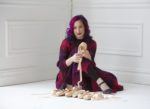 You might not have heard about this, but today is the first day of Anti-Bullying Week. You might wonder what that has to do with a music website, so I’ll tell you. The incredibly gifted singer-songwriter Rachael Sage (who we interviewed a few weeks ago) is supporting the anti-bullying charity Ditch the Label by donating the proceeds of her latest single to the charity.
You might not have heard about this, but today is the first day of Anti-Bullying Week. You might wonder what that has to do with a music website, so I’ll tell you. The incredibly gifted singer-songwriter Rachael Sage (who we interviewed a few weeks ago) is supporting the anti-bullying charity Ditch the Label by donating the proceeds of her latest single to the charity.
The single, “I Don’t Believe It” has been taken up as an anti-bullying anthem following the online success of the video featuring eleven-year-old Kaci King, three-time national dance champion who contacted Rachael on Facebook after hearing her songs. The video and the song are both superb, so why not buy a great song and feel good about yourself because the proceeds are going to a good cause?
And have a look at the video as well:
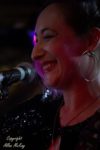 As far as interviews go, I think I’ve been really lucky. In six years, I’ve never had that experience of the uncooperative, bored, jet-lagged or just plain hostile interviewee. I’ve had to work in cupboards stage-side while rock bands soundchecked, but everyone I’ve met has been interesting and charming. I’m pleased to say that Rachael Sage (singer, songwriter, guitarist, pianist, artist and designer) extended my winning streak when I met up with her before her performance at the Discovery showcase at 229 on Great Portland Street to talk about her new album “Choreographic” and her current UK tour (among other things). I even added a new Yiddish word to my vocabulary. Here’s how it went:
As far as interviews go, I think I’ve been really lucky. In six years, I’ve never had that experience of the uncooperative, bored, jet-lagged or just plain hostile interviewee. I’ve had to work in cupboards stage-side while rock bands soundchecked, but everyone I’ve met has been interesting and charming. I’m pleased to say that Rachael Sage (singer, songwriter, guitarist, pianist, artist and designer) extended my winning streak when I met up with her before her performance at the Discovery showcase at 229 on Great Portland Street to talk about her new album “Choreographic” and her current UK tour (among other things). I even added a new Yiddish word to my vocabulary. Here’s how it went:
Allan – Hi Rachael.
Rachael – Hello.
Allan – How’s the tour going so far?
Rachael – The tour’s been really great. This tour’s a little bit different because, in addition to the club shows at night, we’re also doing workshops in the daytime along the tour route at various schools, either performing arts schools or the dance and drama departments of general schools along the way and it’s been fascinating. I’ve never really done that before; I’m not a teacher, I’m kind of inexperienced at that, but I seem to have a special relationship with kids between nine and fourteen so we’ve been enjoying and learning a lot.
Allan – And presumably that means that you’re performing at unusual times.
Rachael – Indeed it does. We’ve had some crazy call-times to meet at the tour van in the morning, like seven-thirty in the morning to drive a couple of hours to perform at 10 a.m. Actually, this morning we played at 9:30. But on the upside, our jet-lag is so confused that it’s non-existent; we don’t know what time zone we’re in. When we go home to New York, it’ll probably be easier to re-acclimate.
Allan – When you come to the UK, do you find the audiences very different from American audiences?
Rachael – I suppose it would be more politically correct to say no, that audiences everywhere and every environment around the world are just about the same, because people are people and we have deduced that people around the world love music the same amount and they all want the same things out of life and there is that unifying theme that we experience. But in terms of audience reactions we’ve found UK audiences and European audiences in general to be a lot more open and expressive when they really, really like something and it’s not necessarily loud whistling or heckling. They’ll come up to you after shows and have that familiarity and treat you like you’re their buddy they’ve known forever and talk to you about their own lives and themselves; it’s just an openness and we love that, that’s part of why we keep coming back.
Allan – I’ve spoken to American artists who think when they start the set that they’re dying on stage and suddenly at the end of the song, the audience erupts.
Rachael – I’ve experienced that to an extreme in Japan, where you think you’re not going over at all; they must hate it, and afterwards there’s the most gentle clapping and they come up to the merch table and they want to buy all your CDs when you weren’t even certain they were into it. People have their own way of processing music and there really is no wrong. As long as nobody throws tomatoes, we’re happy.
Allan – I understand there’s an interesting event you’re involved in at the end of the tour as well at the Royal Albert Hall.
Rachael – The Dance Prom? That’s an event where we’re running a contest and the school that performs the winning routine to one of my songs will receive a scholarship from my record label Mpress Records and myself. I’m not performing at the event, but it’s very much tied in to the “Choreographic” dance theme of this tour. We’re going to be back in London at the O2 Academy in Islington on October 28th, and The Bedford on November 1st. Looking forward to that.
Allan – For the benefit of the MusicRiot audience, tell me a bit about your background, because it’s been very varied, hasn’t it?
Rachael – It has, and yet everything has had the thread of music really. I started playing piano by ear when I was about two and a half/three years old which the exact same time I was thrust into a pre-ballet where really all you’re doing is running around and spinning around and having fun, somewhere for you to be busy while your Mom gets a break, but it quickly bloomed into a full-blown young ballet career and I ended up becoming quite serious as a ballet dancer and at the same time very serious about being a songwriter. I learned to play by ear pretty much exclusively from sounding out all the music I heard every day in dance class. So I would go home and play all these classical pieces and I have no knowledge of the composers or what they were called because it was an informal education, but it was a very thorough education and I think my sense of melody and dynamics really stemmed from classical music.
Jumping ahead, I kept the songwriting up and I pretty much knew, I wanted to be a professional singer/songwriter and composer well before high school, maybe at thirteen/fourteen. Then for my Bat Mitzvah, my relatives got together and bought me a four-track tape recorder. Once I mastered that, I fancied myself as a budding producer, bouncing vocal tracks and having a good time with that, and by the time I went to college, I was very firm that I wanted to be a recording artist and tour the world doing pretty much what I’m doing now, so I guess I was a planner.
Allan – I’ve spoken to artists who agonise about the genre they’re working in and the way it affects sales of their work…
Rachael – There’s an expression in Yiddish that I have to respond to that; it’s spelt F-E-H. Genre’s a useful tool to help maybe turn people on to your music to be able to describe it in an elevator pitch, as they say. Actually, yesterday another writer asked me ‘How would you describe your music in three words?’, and I said colourful chamber pop. The reason I said that was first of all, I’m in England and I feel like you have a unique appreciation of pop music and also that pop music is a broader genre here. If you say pop in America, people assume you mean Katy Perry and here it could mean The Beatles or Elvis Costello, you know, pop/rock, so it’s broad enough to feel like I’m at home in that category.
Allan – With “Choreographic”, you’ve pretty much invented your own genre, haven’t you?
Rachael – Oh my goodness, thank you. I didn’t invent the word, unfortunately. I guess what I did, what’s interesting is that my music was being used and embraced by the lyrical dance community in America and also over here well before I was aware of it and then a few of my diehard supporters started sending me YouTube links where I would see these full-blown dances to my songs in competitions and winning awards and I didn’t really know about that competitive dance culture because the in dance culture that I grew up with, there were no contests; it was strict ballet and that wouldn’t have been allowed, but it was fascinating to see these young, very prodigious, hard-working kids performing and interpreting the music in a way that that was completely different from how I might have envisioned it and sort of humbling. At the end of the day, you create it and the minute it comes out of you, it’s really not yours anymore; it’s collective ownership and I love that. Eventually when the show ‘Dance Moms’ started using the music, it brought me back to that time in my youth when dance was a huge part of my life and it defined who I was as a person and I hadn’t really thought about that time for a long time. When you’re a former ballerina, you kind of put it behind you because there’s some bitter-sweetness; it was painful and very gratifying, like breaking up with an ex-boyfriend or girlfriend. You move on and you let it go, but this was a good time to revisit it and come at it musically from a more positive angle, I would say.
Allan – With “Choreographic”, there must be certain elements that make it work for that kind of interpretation.
Rachael – Yes, what happened originally was that they were using all these different songs from various albums of mine and of course there were different types of songs on those albums, but the ones they were using were usually very pianistic and very arpeggiated. I guess the average person might say there were hints of classical technique in the piano playing, and then also a lot of stringed instruments, cellos and violins, so I picked up on that. More than anything when I sat down to make this album, I tried to come at it more from a visual perspective of what I thought would work in a multi-media context with dance and music and I could only go by what my imagination was offering. I have done some choreography in my day, it’s not my forte, but I’m such an avid fan of dance and choreography in general that I have a pretty good sense of dynamics and what might be danceable, so that’s really where I was coming from. I also had the visual in my head of perhaps, one day, bringing one dancer or several dancers on tour with me and doing more of a show that’s theatrical as well as pop and that’s still in the works. We’re thinking about mounting something along those lines in New York in January.
Allan – Presumably, as well as the musical side, it has to have a fairly strong narrative as well. Your songs tell stories.
Rachael – Well, the genre of dance which has embraced my music most has indeed been lyrical dance, which is this term I had no familiarity with and I see these young girls, sometimes boys, but not as often, interpreting the music, usually very literally. I have a song called “Barbed Wire”, which was performed on ‘Dance Moms’ and the song itself is about someone in your life who can’t make up their mind and they’re very ambivalent, and how frustrating that is for you when you are certain how you feel. I think adults or maybe contemporary professional dancers might have interpreted it with more of an abstract approach, where you felt the emotion but it wasn’t quite so literal and of course the ten/eleven/twelve year olds literally had a backdrop of a barbed wire fence and were climbing it and interacting with it, and that was so interesting because it hints at the idea of doing a live show where the average person sometimes does need those very accessible touch zones to identify with a new art form.
Allan – Is it true that you actually wrote the album here in London as well?
Rachael – I did, yes. I wrote it in Camden. I had two festivals pretty far apart for me. I like to fill every single day, because I’m a busy OCD kind of an artist and I don’t like days off; they make me nervous. We were coming up on those shows and we had choice between trying to pick up some radio in between or just leave that gap and I said ‘You know what, it’s time for me to write a record.’ I’ve never quite set that deadline for myself before. I usually just let it happen organically; over the course of a year, I write twelve songs and then I have an album and then I’m ready to go record, but I had recently reunited socially with my co-producer from many, many years ago, Andy Zulla, who did my first few records with me, and we hit it off again so beautifully and we got all excited to collaborate again. He said to me ‘When you come back from England, if you have a batch of tunes ready, I can record with you in August and then I’ll be busy again after that, but keep me posted.’ That was a driver as well; I wanted to come back armed, like a fashion designer would feel: ‘I want that fall line all ready to go’. I had five days in Camden, so I holed myself up in a hotel, ditched the car and the tour van and stayed at a Holiday Inn Express. I’d go walking every day and just take in the energy of the city and then I wouldn’t let myself go to sleep unless I’d written at least one song. So that’s the story of how this record was written. It was during Glastonbury Festival too so that was what I watched if anything on the television and it kind of inspired me as well.
Allan – Apart from music and dancing, you have other artistic interests as well, haven’t you?
Rachael – I do, and that’s also why I was drawn to the word choreographic, because I’m a visual artist and I’m a graphic designer, but it evolved more out of necessity than anything else because I run my own record label and when you do that you have to wear a lot of hats, so there have been times when I felt I would just do better designing my own artwork because I had a specific vision. I just figured it all out and so there’s that graphic, visual aspect to my work and there are many artists I admire who have that as well like David Bowie, Kate Bush and David Byrne, so many artists, even John Mellencamp, Tony Bennett, who I admire and I’ve become very interested in their artwork as well and that helps me to have a window into another side of them. I hope that people explore that aspect of my work as well and I have a section on my website, ’Visuals’, where you can see my paintings and collage, and just recently I developed some wearable art; I’ve been painting on jackets and dresses and things like that and it’s just another fun outlet for me creatively.
Allan – I’m always fascinated that most of the very gifted musicians I know have various other artistic interests, like photography, as well…
Rachael – Probably keeps them sane…
Allan – One last question, is there any particular song that always make you cry?
Rachael – My favourite contemporary folk artist is Glen Hansard. I was recently at his concert at Carnegie Hall and I was weeping like a little baby. It’s on his new record. He composed the music for the movie “Once”, which was such an incredible music film and the song’s called “My Little Ruin”. He’s an Irish songwriter who was with The Frames with and there was a Broadway show created from “Once”, which won the Oscar for best song and it ran in the UK and Ireland as well. He’s in the vein of Damien Rice, that kind of vibe, beautiful string section, acoustic guitar and I’m a big Irish music fan. Anything Irish makes me cry.
Allan – Many, many thanks Rachael.
Rachael’s album “Choreographic” is released in the UK on November 11 on MPress Records. You can also see photos from Rachael’s performance at 229 here.
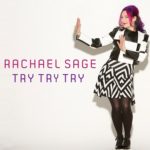 Despite all the dire predictions, there’s still an awful lot of really good music out there at the moment. The downside of this is that it can be difficult to make your songs stand out from the rest. Rachael Sage passes the old grey whistle test on “Try Try Try” with a slightly unusual arrangement, using a combination of slightly distorted violin and electric guitar as lead instruments and a mix of electric and acoustic guitars. It’s easy to see why this made number six on the radio chart in the US; it opens like a Tom Petty song before the intimate, close-miked vocal cuts through, followed by an outrageously catchy violin hook. For the soul fraternity, there’s horns and a Hammond; there’s even a violin solo closely followed by a guitar solo and an acoustic breakdown. All the elements for a great single are there and they’re put together beautifully.
Despite all the dire predictions, there’s still an awful lot of really good music out there at the moment. The downside of this is that it can be difficult to make your songs stand out from the rest. Rachael Sage passes the old grey whistle test on “Try Try Try” with a slightly unusual arrangement, using a combination of slightly distorted violin and electric guitar as lead instruments and a mix of electric and acoustic guitars. It’s easy to see why this made number six on the radio chart in the US; it opens like a Tom Petty song before the intimate, close-miked vocal cuts through, followed by an outrageously catchy violin hook. For the soul fraternity, there’s horns and a Hammond; there’s even a violin solo closely followed by a guitar solo and an acoustic breakdown. All the elements for a great single are there and they’re put together beautifully.
“Try Try Try” is released on Friday September 30th and Rachael’s album “Choreographic” follows on Friday November 11th on Mpress Records.
If you want to see Rachael in London, she’s playing at The Troubadour on Friday September 23rd.
Here’s the audio-only clip of the single:


